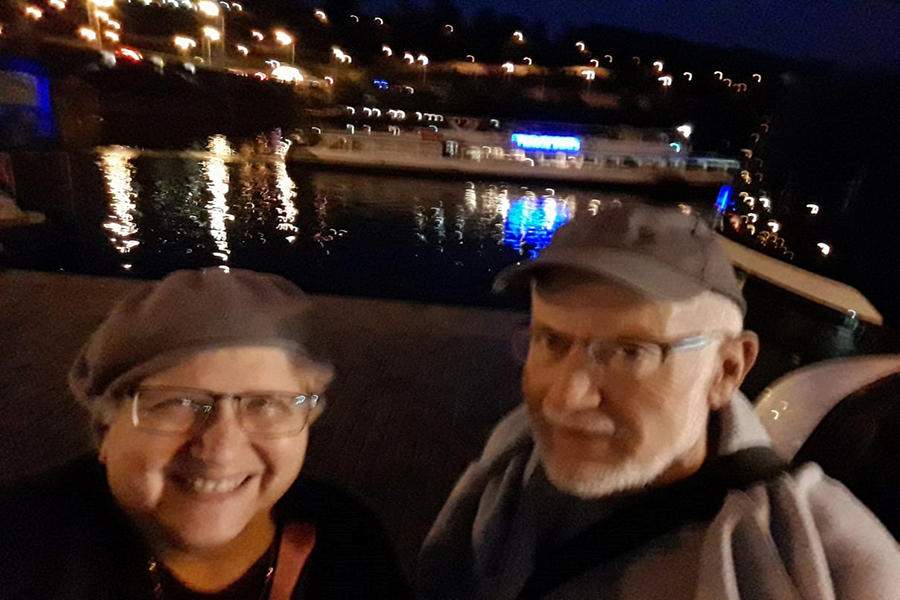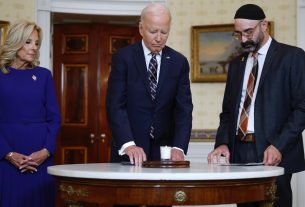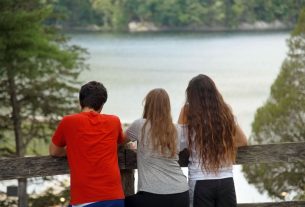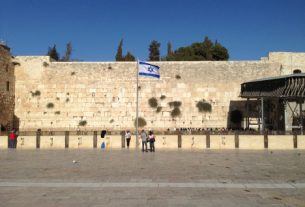On September 11, 2001, I gathered together the actresses of Raise Your Spirits Theatre in Gush Etzion. We had created our theater troupe that summer, in the midst of a bloody intifada in Israel, and made a decision to not cancel rehearsals or performances on the day of a terror attack. We opened our rehearsals with the reciting of Tehillim.
But nothing of this magnitude – the sheer numbers – had happened thus far.
‘);
_avp.push({ tagid: article_top_ad_tagid, alias: ‘/’, type: ‘banner’, zid: ThisAdID, pid: 16, onscroll: 0 });
I told our actresses, “I only discovered a month ago, through a distant cousin, that I had relatives who died at Theresienstadt. They may have been theater people. We’re not at Theresienstadt and this isn’t the Shoah, and we’re performing. But anyone who prefers not to, can sit it out.” No one chose that option.
On the advice of one of our rabbis, we opened the show with the reciting of Tehillim, said by almost 500 women – audience and cast – and retained, to this day, the custom of opening every show with Tehillim. It was also the first time we ended the show with the singing of “Hatikva” and “Ani Maamin,” also a custom we have retained to this day.
From that moment I wanted to visit Theresienstadt.
Back to Roots
My husband was born in Slovakia, when it was Czechoslovakia, to parents who survived the Shoah hidden in an underground storeroom in Trnava, about 30 miles from Bratislava. He is descended from Rabbi Yom Tov Lipman Heller, author of Tosfos Yom Tov, who studied under the Maharal of Prague, so his connection to the area was very personal.
I wondered about every Czech person we met (they were all lovely) – did their parents or grandparents help or hide Jews during the Shoah, or did they stand along the sidewalks and cheer on the Germans as they entered the city? I loved the magnificent architecture and taking my photo next to a statue of Franz Kafka, but my soul couldn’t escape the past.
We stayed at the beautiful old-world style Hotel Caruso (with kosher breakfast) and our first day in the city was spent in the Jewish Quarter. Today the once exquisite synagogues are mostly museums, though there are services in a few of them on Shabbat. The Maisel Synagogue, in addition to housing historical and religious artifacts, has a haunting three-dimensional presentation of the Jewish Quarter as it once was. I wondered what distant cousins of mine ran along these cobble-stoned alleyways playing or chasing a ball? A tour guide told us that so many religious artifacts were preserved because Hitler had planned to create a museum of the Jews as an extinct people.
A Memento and a Memory
Our first stop that morning had been in an antique shop, as I was seeking a special gift for our daughter-in-law, who had just turned 30. I purchased a lovely ring, more than a hundred years old. The proprietor told us that the items in the shop were either from private collections or bought at auction. I asked her if the items that were auctioned might have belonged to the Jews before the war. She said yes. At least one of those (possibly stolen) rings has achieved redemption, as it now sits on the hand of a lovely young woman in Eretz Yisrael.
In the Pinkas Synagogue walls are covered with the names of Jews who had been deported from Prague and the surrounding area – 77,000. According to the Jewish Virtual Library, more than a quarter of a million Czech Jews were murdered in the Shoah. Somewhere on those walls are the names of my relatives.
Upstairs was a display of art by the children of Theresienstadt that reveals fears, memories, impressions of real life, and dreams for the future, like the child who painted boats on the sea on their way to the land of Israel. There are even pictures of transports and executions. Their painting teacher, artist Friedl Dicker-Brandeis, helped them cope, the ultimate art therapy. The majority of these children perished.
A Mikvah and a Cemetery
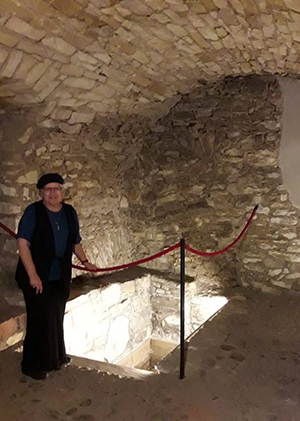
The Pinkas Synagogue leads to an ancient mikvah. As co-creator of the show “Mikva the Musical, Music and Monologues from the Deep,” I have a new curiosity about mikvaos around the world. Our guide, Jan Stefan, told us the mikvah is from the 16th century, and discovered only 50 years ago. There is a small anteroom, where the women may have prepared themselves, and a built-in stone fireplace. When I asked him why he felt such a connection to the mikvah, he said, “I feel it has great spiritual power for myself and for the Jewish history of my family…”
The famed Jewish cemetery, next to the Pinkas synagogue, is a study in history and scholarship ensconced in nature. Among the many luminaries buried there are the Maharal, the Kli Yakar, (one of my favorite commentators), and David Gans, a student of the Maharal who was also a scientist. A walk through the cemetery leads to the 700-year-old Altneuschul of the Maharal, with ceilings so high you can hear an echo – of generations past? Of the elusive golem, that legend says is still in the attic? One of the pesukim on the walls, a line from Kohelet, proclaims, “Fear G-d and keep His commandments for that is the whole [purpose of the] person.”
There is a legend that the foundation stones of the Altneushul were brought from the destroyed Beit HaMikdash and that they are “on loan” until it is rebuilt.
Later we made the long trek to the beautiful Jerusalem Synagogue, not in the Jewish Quarter. As we passed through the Old Town Square, surrounded by coffee shops, palachinka and sandwich stands, bordered by a park with tall trees and birds, my vision changed from color to black and white as I tried to access the collective memory.
The magnificent Jerusalem Synagogue, built in 1906, was used as a warehouse by the Nazis during the war. Unlike the Altneuschul, whose women’s section is only thin slits in the wall, the Jerusalem Synagogue has a large elegant women’s balcony, looking down on the bima and Aron Kodesh from all three sides.
It is customary when one enters a shul, to say at least a short prayer or recite a psalm. I found no prayer or psalm books in the synagogues I visited (perhaps they were packed away somewhere) so I recited the first psalm that came to me, by heart, which is “Shir Hama’alot. A song of ascents. When the Lord returns the returnees to Zion, we shall be like dreamers.”
Theresienstadt
The next day we drove to Theresienstadt, through villages and farmland. What did the Jews think awaited them as their trains rumbled by these peaceful villages?
Theresienstadt does not look like a concentration camp, rather it is a quaint town today, with landmarks of Jewish Holocaust-related buildings scattered throughout. The exhibits in the main building indicate how the prisoners tried to maintain clinics, lessons, and hold plays and concerts. It is tribute to the Jewish spirit of survival that among those conditions of horror, hunger, and deportations to death camps, they tried to achieve a degree of “normalcy.”
We visited the train platform, and the nearby room where Jews came to bid farewell to those who had died, before they were taken to the cemetery and ultimately cremated.
For me, the most moving part of the visit was seeing the tiny prayer room, tucked away behind a private courtyard. They had decorated the “shul” with pesukim and maganei David, perhaps to replicate one of the beautiful Prague synagogues. The pasuk at the head of the room was, “And may our eyes see when You return to Zion in compassion.”
When we got back to our hotel that night, I checked my mail. At the exact moment I was standing by the theater poster display of Theresienstadt, an American Jewish playwright-director was sending me an email, consulting with me about a play he had produced about the Shoah.
Communism, a Castle and a Concert
The next day we visited the Museum of Communism, a shocking and eye-opening experience, with graphic exhibits of the suppression of free speech, of the theft of homes and farms that had been in families for generations, and the details of torture and hangings. My husband’s parents came to Israel in 1949, with three young children. He turned away from one of the exhibits and said, “A little while longer and we would have grown up under Communism.”
We enjoyed happier elements of the city – a boat tour, a trip to Prague Castle and a concert of Vivaldi, Ravel and others, including Smetana’s “Vltava” with its recognizable strains of what we know as “Hatikva.” The circle closed.
What could be more appropriate than to get on a plane the next day, and fly home to the land that is no longer a dream?
‘);
_avp.push({ tagid: article_top_ad_tagid, alias: ‘/’, type: ‘banner’, zid: ThisAdID, pid: 16, onscroll: 10 });

